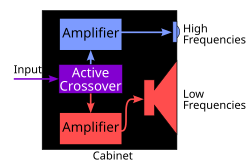
Powered speakers, also known as self-powered speakers and active speakers, are loudspeakers that have built-in amplifiers. Powered speakers are used in a range of settings, including in sound reinforcement systems (used at live music concerts), both for the main speakers facing the audience and the monitor speakers facing the performers; by DJs performing at dance events and raves; in private homes as part of hi-fi or home cinema audio systems and as computer speakers. They can be connected directly to a mixing console or other low-level audio signal source without the need for an external amplifier. Some active speakers designed for sound reinforcement system use have an onboard mixing console and microphone preamplifier, which enables microphones to be connected directly to the speaker.
Active speakers have several advantages, the most obvious being their compactness and simplicity. Additionally the amplifier(s) can be designed to closely match the optimal requirements of the speaker it will power; and the speaker designer is not required to include a passive crossover, decreasing production cost and possibly sound quality. Some also claim that the shorter distances between components can decrease external interference and increase fidelity; although this is highly dubious, and the reciprocal argument can also be made. Disadvantages include heavier loudspeaker enclosures; reduced reliability due to active electronic components within; and the need to supply both the audio signal and power to every unit separately, typically requiring two cables to be run to each speaker (as opposed to the single cable required with passive speakers and an external amplifier).
Powered speakers are available with passive or active crossovers built into them. Since the early 2000s, powered speakers with active crossovers and other DSP have become common in sound reinforcement applications and in studio monitors.[1] Home theater and add-on domestic/automotive subwoofers have used active powered speaker technology since the late 1980s.
- ^ Kuells, Jeff (September–October 2001). "Amped Up: Active Speaker Designs: Less Cost for a Total System?". Live Sound International. Archived from the original on 2012-07-22. Retrieved 2011-11-13.